Drag Kings Just Want to Have Fun and Get Their Due
Article #2 of Simi Horwitz’s ongoing series on alt-cabaret.
Drag King Mo B. Dick (aka Mo Fischer), best known for his self-defining quip, “Instead of being an angry woman I became a funny man,” reluctantly admits it’s never been a better time for drag kings. Thanks to the shuttering of live venues, drag kings—performing artists of all stripes—have been forced to use digital platforms and in so doing may succeed in expanding their audience beyond their wildest expectations. Hosting the variety show, “Kings of the World” on a live streaming platform (twitch.tv) the third Wednesday of every month, he has every hope that viewership will keep growing.

And it’s not a moment too soon. Currently based in Los Angeles, Mo is a seminal figure who launched drag-kingdom in New York in the ’90s and knows that kings do not enjoy the same visibility as drag queens. Until last season’s “Dragula,” for example, no American reality TV show featured drag kings. Compare that with the long-running “RuPaul’s Drag Race,” the hot drag queen show. And, worse, drag kings have virtually no presence in mainstream cabaret either.
“It’s a man’s world,” Mo says dismissively, adding that drag queens, however they self-identify, are assigned male at birth, and simply preferred by the public at large. Mo believes a sea change may be in the offing. To that end he’s appeared in many documentaries on the topic (e.g., Venus Boyz); he’s been quoted in various scholarly works (e.g., by Judith (Jack) Halberstam); and he’s co-created an online drag king history, http://dragkinghistory.com/—all in an effort to generate greater interest in an under-appreciated art form with a long backstory.
Drag kings do enjoy a following in alt-cabaret settings—e.g. in downtown Manhattan and Brooklyn—where they may perform skits with other drag kings (sometimes drag queens too) and incorporate song, dance, lip-synching, circus skills, and even burlesque into their shtick. Kitsch and camp are alive and well. They are often as spectacularly decked out as their queen counterparts and they may employ high tech special effects. Many bind their breasts and pack dildos in their trousers. In addition to Mo the better known drag kings include: Wang Newton, Freddy Prinze Charming, Landon Cider, and Vigor Mortis, among others.
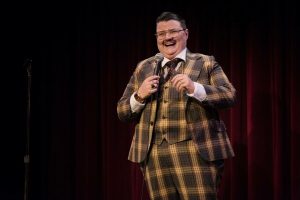
Perhaps the most popular is veteran performer Murray Hill, a lounge-lizard emcee with slicked-down black hair, a shiny baggy suit, and a fake mustache. Dubbing himself “the hardest working man in show biz,” he evokes Ralph Kramden playing everybody’s favorite uncle at the dinner table after a few drinks. Minus the tuxedo and corny one-liners, he continues as Murray Hill offstage, but will not say if he’s a trans man, gay, non-binary, or queer. “I’m something else altogether,” he remarks cryptically, pointing to just how gender fluid the drag scene and its players have become. (The same is true for drag queens: https://bistroaward.com/the-evolving-genre-gender-bending-art-form-known-as-drag-is-one-big-hybrid/)
All agree opportunities are slowly expanding and there’s an explosion in drag king expression. Mo’s drag persona—a swaggering, low IQ sexist, homophobic clown voicing a thick Brooklynese accent and sporting a gold tooth, cheap suit, and an exaggerated pompadour—was right out of a feminist playbook. It was the perfect vehicle (in the ‘90s) for commentary about toxic masculinity and, at the same time, afforded Mo the chance to “take up space” like a man.
Drag kings may still play the rude dude (cowboy, rock star, macho man), but perhaps today he’s often defined by a lighter touch and a smidgen of affection, even as he’s being parodied.
Many drag kings were (and are) lesbians, others trans men, and still others were (and are) bisexual or furious/frustrated/fed up straight women. Mo defines herself as “a bisexual cisgender woman married to a man.”
The etymology of the word “drag” is arguable, though some suggest it dates back to the vaudeville era of the 1870s, or even Shakespearean times when it appeared as a stage direction referring to a male actor Dressed As a Girl (DRAG).
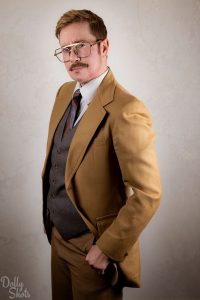
Drag King Flare, known offstage as Flarington King, a Toronto-based producer/performer/drag king documentarian, views the term through a larger lens: “‘dressed as a girl,’ ‘dressed as a guy’ ‘dressed as a gender.’”
Onstage, Flare may play a macho straight man, an effeminate gay man and even a burlesque performer, what Flare dubs “draglesque.” “As a drag king I’ve twirled tassels on my breasts.”
Performing in drag is a declaration of freedom and an opportunity to explore a range of gender identities and other forms of artistic expression, Flare asserts. Consider Drag King Lou Henry Hoover, both hoofer and stripper, who incorporates the two talents into his drag performance. Drag King “Richard,” on the other hand, performs a sexy strip tease to the music of Ginuwine’s “Pony,” morphing into a small horse in the process.

Drag King Goldie Peacock, acknowledges the “stick it to the man” and “claiming our power” elements in many drag king performances. Still, there may be more at stake than gender identity politics.
In a number dubbed “Stronger,” Brittany Spear’s legendary song, Goldie enthusiastically lip-synchs the words, while bounding around the stage in a cut-out leotard, adorned with a red- and white-striped bib. Muscled arms and legs and mustached too, Goldie’s presentation is androgynous.
Playing a weak strong man, Goldie futilely attempts to lift an erect tin-foil phallus off the floor. One failure follows another and then with a sudden burst of strength—after a self-injected steroid shot in the butt—Goldie hoists the phallus in the air and proceeds to play with it in an array of comically lewd positions.
Contrary to what one might anticipate, Goldie asserts, “For me the piece is about America’s over-inflated sense of itself.”

Vigor Mortis, a drag king affiliated with the Brooklyn-based collective, Switch ‘n Play, boasts a wide esthetic gamut too—from creepy, crawly genre horror to turn-on-its-head absurdity.
Vigor says he is a “trans masculine non-binary person, who challenges ‘desirability politics.’ I’m a chubby, short, trans person, part clown, part Vegas, part drag. People who see me don’t always know what to think of me at first, and I try to use that to capture their attention and imagination. I’m loud, flamboyant, and flirt with the audience. I’m sexy and joyous. That’s what I strive for: joy. Is it political? All drag is inherently political, even—especially—showcasing joy!”
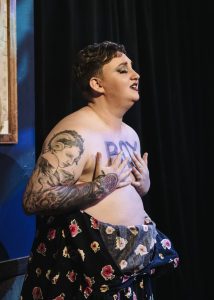
His performance can also be unexpectedly sad. In one disturbing piece, he evokes a lost-soul man in drag, costumed in a chiffon gown with a giant bow on his head. His burly arms are blanketed in tattoos. He faces the audience and lip-synchs the haunting words to “Mad World” as he begins to disrobe, removing the head covering (bow and wig), and finally dropping his dress to the floor revealing the word “Boy” in black paint scrawled across his chest, above large, round women’s breasts.
What’s the Appeal?
The career trajectory and motivation of drag kings vary. Some are performers with dance and/or theatre backgrounds. They may be initially drawn to drag for its off-the-beaten path aesthetic. Others are attracted to its political underpinnings, and still others are experimenting with gender identity issues. For most it’s a combination.

Arizona-based Freddy Prinze Charming was always performing in one community theatre production or another, but by the time he arrived at college and “presented as a masculine woman, there were few roles for me,” he recalls. “I was not comfortable playing a man and I was not comfortable playing a woman either.”
Within a few years he had come out as a lesbian, was much impressed with Sarah Water’s novel, “Tipping the Velvet,” which deals with male impersonators in Victorian England, and decided to audition for a drag troupe. “I was just terrible,” he says.
He differs from many drag kings in that his onstage persona is devoid of raunchiness, sexual puns, or innuendo. Blue comments and crude acts have become the default performance choice for others, but he aspired to present a personable chap and it came naturally to him.
Everyone said he was “charming” and when he heard the name “Freddie Prinze” in passing, he had his new moniker and onstage persona all rolled into one. “I am making no comment about Freddie Prinze,” he stresses.
At the same time, he was beginning his transition acknowledging that the drag performance experience was a vehicle for that transition, not that he knew it at the time. He did know, however, that he was more comfortable in his male persona.
Among his onstage characters there’s the ‘70s sleazy car salesman and a leather daddy. He’ll occasionally impersonate Elton John, but for the most part his onstage alter-egos are figments of his imagination. “I’m not an impersonator,” he insists. “I embody styles.”
Asked how his performance has changed post transitioning, Freddy says that even before his transition he played “softer masculine” characters. Still, he was far more concerned with appearing “masculine” than he is now. He no longer has to prove anything. He is a man and free to play with gender in a whole new way.
“Transitioning gave me the freedom to wear makeup and even heels,” he says. “It gave me the freedom to push the gender boundaries.”
It’s not unusual for Freddy to spend two-and-a-half hours getting into makeup. It’s a process which includes foundation, beard, eye-brows, and eye-liner. “My makeup case weighs fifteen pounds,” he says, loving the fact that he has found himself in the world of non-binary gender roles on and off stage.

“The definition of drag has evolved,” he continues. “Over the years drag has become less about performing the ‘opposite gender,’ and more about the art that has gone into it.”
He points out that a woman can be a drag queen. At one time they were known as “faux” queens. But that word is no longer acceptable he explains. “It suggests they can’t be real drag queens. Why not? Trans men can be drag queens too. It’s all a spectrum. If people see me on the street they assume I’m a gay cisgender man. I’m gay but I’m a pan sexual queer poly-trans man.”
That’s a hard one to parse and perhaps that’s precisely the idea. Off and onstage drag kings befuddle, provoke, “deconstruct” (to quote Flare) and may do so deliberately.
Why Do Drag Kings Lag Behind Their Female Counterparts?
Ron Lasko, a Spin Cycle press rep specializing in the downtown cabaret/theatre scene, voices what many think. “The disparity between the mass popularity of drag kings and drag queens has always been fascinating,” he says. “I think it comes down to this: drag queens tend to celebrate the beauty and strength of women, while drag kings tend to play upon the more boorish, toxic aspects of masculinity that most of us would rather not be reminded of. While both types of drag are inherently political, drag queens are just more fun overall. And fun sells.
“Drag queens and real women also have an infinite variety of fashion, makeup, and hair styles to choose among,” he continues. “Drag kings and men are far more limited in options. And then there are just basic mechanics: it is easier to add breasts than to flatten them; and even a bad wig looks infinitely better than an okay bald cap.”
Flare says that in the 1860s-‘70s in the States and UK, drag kings were revered. Drag was a full-time gig and kings could enjoy a 55-year career. Male impersonation, as it was known then, was a well-paid, venerated art form.
Sporting tails and top hat, these illusionists could “pass” and presented a positive reflection of masculinity to an audience largely made up of soldiers and working class men, Flare notes. Their politics centered not so much on gender identity, but rather class issues.
“They might be playing wealthy men who were falling down drunks or effeminate dandies,” continues Flare. “The audience loved it when they were mocking the wealthy. The male impersonators were the great equalizers.”
Lillian Faderman, an LBGT historian and best-selling author, suggests that male impersonators of that era were family friendly as well. They might be singing romantic songs to women, but there was nothing risqué about it. Everyone could enjoy a woman playing a man and doing it so well.
“Maybe they were lesbians or trans persons, maybe there was always gender fluidity,” she says, “But we didn’t have the vocabulary for it. Vocabulary creates ideas.”
From approximately the mid-‘20s to the mid-‘90s, drag kings continued to exist, but mostly in underground night spots. Flare blames the cultural/political conservativism of the era for diminishing the drag king’s prestige and audience. The film industry, eroding live entertainment across the board, also played a role in the “disappearance” of the drag king.
But in the ‘90s and into the early 2000s with the advent of lesbian-owned cabarets and especially in the flush of the feminist movement, drag kings enjoyed some small resurgence awash in gender identity politics. The hot kings included Shelly Mars, Diane Torr, Elvis Herselvis. Drag King Conferences, extravaganzas, and workshops surfaced in cities across the countries. Some of the workshops instructed women on how to look and behave like men. In several instances they were encouraged to walk into pool halls or other male bastions to see if they could pull it off and, more to the point, what maleness felt like. Some carried the experience onto the stage in drag acts.
For the most part, drag kings and drag queens lived in separate worlds. But in the wake of the 2008 market crash, economics served as a catalyst for change. Drag kings and queens were forced to share rehearsal space and in the process began humanizing each other. Many drag kings—previously feeling invisible to or even patronized by drag queens— saw their female counterparts in a new light (and vice versa). They allowed themselves to appreciate the drag queens’ aesthetic, realizing there was something to be said for glitz, glam, and flamboyance. It brought in an audience.
It also reflected social and cultural shifts that celebrated the non-binary. Switch ‘n Play, among other drag collectives, spans the queer gender spectrum. So do Cake Boys, also out of Brooklyn. Many drag kings are part of collectives. Repeatedly I was told cabarets are far more likely to hire a drag king collective than a solo act, unless the latter is very well-known. Drag queens have been one-person acts for decades.
All of it begs the question: who is more transgressive, the drag king or drag queen, and to what degree (if any) does that determine their respective popularity?
Some might say that for mainstream audiences, a man dressing up like a woman (even if it’s a woman he adores) is an act of self-degradation and thus, more unsettling and transgressive. What man ever wanted to be called a sissy?
By contrast most of the drag kings I interviewed suggest that a woman strutting about macho-man style is more challenging to the status quo, even today. They say that’s one of the reasons drag kings continue to be marginalized.
Faderman had an unexpected spin, contending that drag queens are more transgressive and therefore more humorous and, by extension, more popular.
Additional Obstacles for Drag Kings of Color
Persons of Color (POC) in the drag king world face an added layer of challenges, yet among those I interviewed, their response to being minority kings reflect no monolithic experience. They are of course aware that they’re relatively few in number; and in some instances (not all) feel discriminated against.
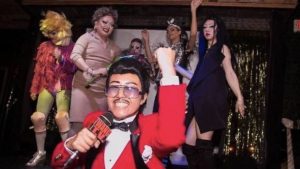
“Do I have actual proof of racial bias?” asks Asian Drag King Wang Newton. “No. How could I prove it? Early on in my career I knew that I had been double-booked as a headliner with another famous white drag king and then un-booked once it was discovered. I would not say it was racist. Rather, I would say unfortunate things have happened.(
“The totality of my struggles feels more like that unconscious bias when an employer recognizes the ethnicity of a name and passes,” Wang continues. “I do know that since I began drag in 2004 until present day 2020, peoples’ minds cannot comprehend ‘drag king’—I constantly get perplexed faces. Conceptually, Asian drag kings may not be comprehended easily. Since 2008, it has been painful hearing feedback of ‘I don’t know why you’re not more famous.’”
The best known and much admired minority drag king was the late Mildred Gerestant (aka Dred), a brilliantly sly gender-bending Haitian-American drag king who died last year and was way ahead of her time in her non-binary persona.
Some acknowledge that the BLM movement may boost the visibility of minority drag kings. Indeed, a few weeks ago Mo produced an all-Black “Kings of the World.” Her support of the BLM movement was her driving motivation. The show faced technological difficulties but Mo’s optimistic it was a door opener.
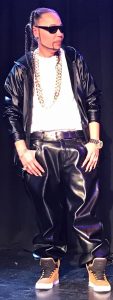
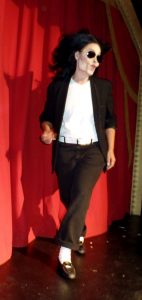
Make no mistake drag kings of color face many challenges, not least the fact that they’re playing with race in addition to gender.
Drag King Duke Madd-Dogg specializes in hardcore rappers. Earlier on in her career she (that’s her off-stage pronoun of choice) tackled a teen right out of the “hood,” sporting pants dropped below his butt. Now, her go-tos are Michael Jackson and Rick James. But she’s never received any flak for her performances and indeed says she feels more vulnerable sending up a macho man than in satirizing a Black prototype (who in her capable hands is actually rather endearing).
By contrast New York’s Uncle Freak (aka Foxy Belle Afrique, aka Henrietta) is deeply conscious of “Uncle’s” skin color and the fact that he’s not an exemplary figure.
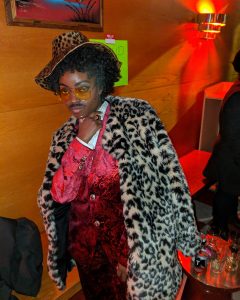
“He’s the Lady Whisperer, the Tequila Lover and the Social Justice Warrior,” she says. “He wears a suit, a cute Afro, a mustache, a beard or a goatee. He represents ‘Uncle’ who is charming, but displays misogynistic behavior. We all have Uncle Freaks in our lives, but ultimately he’s a loveable jerk.”
Most women in the audience—Black and white—understand and enjoy where she’s coming from. Black men many not always be enthusiastic. “Black men often have very definite ideas about what a woman should and shouldn’t do in public,” Henrietta says. “And then to create a caricature of a Black man is a turn off to many of these guys. “I had one Black photographer who said I was not contributing to Black unity, but rather contributing to the dismantling of the Black Family.”
Asked how—if in any way—Black kings compare to white kings in terms of what they present onstage, she says they may be more openly political, talk about social issues, economics, and oppression. And that doesn’t always go over, especially with some white audiences who want to have fun at a cabaret and feel free to tell her so, suggesting she revise her act.
Still, whatever shortcomings exist on cabaret stages in New York, Henrietta does not forget where she came from: Uganda, where in all probability she’d be arrested for what she does on stage here, she says.
Affectionately toying with a Wayne Newton-like persona—reveling in his glitz, glam, and celebrity—the Taiwanese born Wang says that his Asian roots inevitably informs his onstage “character,” if for no other reason than it’s unexpected: “an Asian female dressing as a cheesy Vegas lounge singer, traveling the world with a sizable bulge in the pants,” he says. “My persona through the Asian diaspora lens can be as simple as teaching Mandarin to the audience or, it can be as complex as breaking character to share heartbreaking coming-out stories similar to my Asian brothers and sisters.”

Hosting the International Asian Burlesque Extravaganza and performing in drag and pride festivals across the globe, Wang defines himself as a sexually queer being, feeling masculine and feminine at the same time. He says non-binary people have always existed in other cultures—most clearly in indigenous tribes where they were revered as medicine people and healers.
“The persona that emerges in drag represents the hope of being totally free,” he says. “It can be scary and dangerous, but it is also fun, funny, loving, and it hurts no one. All shows are about community and cheering each other on.”
Echoing the other drag kings interviewed Wang says putting gender and race aside, what makes drag radical, especially “in this present-day climate, is its unbridled joy and playfulness. It is being loving and sassy with your chosen family, not always one’s biological family, entertaining those that have walked a similar path, or sharing connection to those that have not.”
About the Author
Simi Horwitz is an award-winning feature writer/film reviewer who has been honored by The Newswomen’s Club of New York, The Los Angeles Press Club, The Society for Feature Journalism, the American Jewish Press Association, and the New York Press Club (among others). She received an Honorable Mention from Folio: Eddie and Ozzie Awards for her two drag stories (May 22, 2020, August 4, 2020) published here on BistroAwards.com. More recently, she was the recipient of the 2023 New York Press Club Award and won three 2023 L.A. Press Club Awards., including first prize for film criticism (for reviews published in the Forward). The publications that have printed her work include The New York Times, The Washington Post, The Hollywood Reporter, Film Journal International, and American Theatre. She was an on-staff feature writer at Backstage for fifteen years (1997-2012).





This is a fantastic article. Always a pleasure to learn more about Drag Kings. I especially enjoyed the POC drag Kings points of view. Where can we follow them?